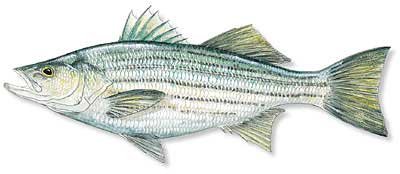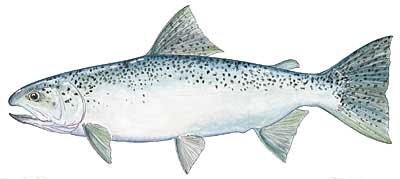Northern California Game Fish
- Sacramento River Game Fish
- Shasta Lake Game Fish
King Salmon
Oncorhynchus tshawytscha
This fish is not called a “King” for nothing. The King salmon is a spirited, beautifully colored fish, that migrates for miles through oceans, rivers, and streams every year to keep the species alive. They can be caught on KwickFish lures and roe. These fish have been known to grow up to 80 lbs and more. They bite hard, run fast, and they’ll give you a fight you’ll never forget. Northern California is well known for its abundance of these fish especially during the fall salmon run in the Sacramento River.

Steelhead
(Anadromous Rainbow Trout)
Oncorhynchus mykiss
This highly prized game fish is an oceangoing trout that comes into the river system to spawn. After spawning, Steelhead return to the ocean to repeat the cycle, and return as larger fish. They are a monster of a fish—very smart—they keep you on your toes through tricks, like trying to break your line by maneuvering it into snags and various other places. They are acrobats that leap out of the water to shake the lure. They can be caught on roe, glo-bugs, various flies and hard crank baits. They can be found in the Sacramento River, the Feather River and the Trinity River where fish up to about 19 lbs have been caught. When you hook one of these, be prepared for a battle of wits.

Brown Trout
Salmo trutta
These marauders stay deep in the bowels of the lake during the warmer months of the year. In the cooler months they come up close to the banks and are very aggressive. They are mainly caught in the winter when they will hunt and eat almost anything. You can catch them on very fast moving baits which they really like to chase down. During the winter, large lures are pulled very quickly along the banks to catch them. They can also be caught on flies, glow bugs, hard plastics, spinners and crank baits. They’re good fighters and are very tasty. They live in freshwater lakes, rivers and streams. Brown trout can be found in most all the lakes of Northern California as well as the Sacramento River. Specimens have been caught up to 38 lbs.

Rainbow Trout
Oncorhynchus mykiss
These battlers are a highly prized game fish for fly and spin fishermen alike. They are wary fish and can be finicky about what they will take or mistake as food. They will go airborne immediately if they are hooked in shallow waters. Their acrobatics can be spectacular and numerous as they try to dislodge your offerings from their mouths. You can catch these scrappers on roe, glo-bugs, live bait (such as crickets and worms), a variety of spinners and crank baits. They are a hard-fighting fish and also great eating. In Northern California they live in freshwater lakes, rivers and streams. They’ve been caught up to about 19½ lbs.

White Sturgeon
Acipenser transmontanus
The sturgeon is a fish that goes back to prehistoric times. They are bottom feeders and have cartilage rather than true bones. They take bait lightly and you must let them take the bait and the hook long enough to get it into their cerbascus (sucker mouths). Hold on tight and don’t let go, because once you’ve hooked one of these guys, you won’t have a fight, you’ll have a battle. You’ll find you have muscles in your body you never knew existed. They can be found in Shasta Lake and the Sacramento River. They grow to be very large and weights have been recorded in the triple digits. They’ve been known to live over 100 years, and some experts believe they can live many years longer. Their full life span is unknown.

Striped Bass
Morone saxatilis
The Striped bass is a saltwater species that comes into freshwater to spawn. To watch them spawn is amazing: they do not make a nest, instead they spawn on the surface. Sometimes when you are just sitting, quietly fishing, you might suddenly see fish everywhere around you. Striped bass are also vicious and powerful, and would like nothing more than to rip your line right off the reel. They’ll attack almost anything that looks like food and have been known to grow up to 75 lbs. They are found in both the Sacramento River and the Feather River.

Largemouth Bass
Micropterus salmoides
These battlers are a highly prized game fish for fly and spin fishermen alike. They are wary fish and can be finicky about what they will take or mistake as food. They will go airborne immediately if they are hooked in shallow waters. Their acrobatics can be spectacular and numerous as they try to dislodge your offerings from their mouths. You can catch these scrappers on roe, glo-bugs, live bait (such as crickets and worms), a variety of spinners and crank baits. They are a hard-fighting fish and also great eating. In Northern California they live in freshwater lakes, rivers and streams. They’ve been caught up to about 19½ lbs.
mallmouth Bass
Micropterus dolomieu
The Smallmouth bass is a cooler freshwater fish. They are found in Shasta Lake, Whiskeytown Lake and Lake Siskiyou. They hit and fight harder than their warmer water cousins, the Largemouth bass. They can be caught with the same baits as Largemouth bass and are a great fish to serve at the table. They grow to about 9 lbs.
Spotted Bass
Micropterus punctulatus
The Spotted bass can tolerate both the cooler and warmer waters. They are the most vicious of all of the bass and will push out the other varieties in their habitat. They can be found in Lake Shasta and Whiskeytown Lake. They’ll give you a good fight. Spotted bass can be caught on the same baits as the Largemouth and Smallmouth bass and grow to about 9 lbs.

American Shad
Alosa sapidissima
Known as the poor man’s tarpon, the American Shad has a life cycle much like a salmon. They’re members of the herring family and are tons of fun to catch. They can be found in the Sacramento River and the Feather River. Although they only grow to about 6½ lbs, you’ll think you are fighting with a much larger fish. They will truly test your equipment. Many 8-lb test lines have been broken by a 3-lb Shad. These are schooling fish and are usually caught in great numbers.

Channel & Bullhead Catfish
Ictalurus Punctatus (Channel)

Ictalurus nebulosus (Bullhead)
While most people believe that a Catfish is just a bottom dweller… nothing could be further from the truth. I prefer to call these fish, “opportunistic feeders”. These fish love live bait! Sure, they will eat your offerings of stink bait, but they love fresh bait too. In most cases, they would prefer live or recently deceased food, over dead and laying bait. These fish “do” use their noses to locate their prey. They generally bite softer than lots of other fish, but once they know they’re wanted, top-side they will go. They’ll go to any length to stay down, and not let you see them. They fight hard, and the bottom is their friend, and “will” find any branch, rock or debri to try and stay there. Catfish, of the Bullhead, Channel, and sometimes White varieties, can be found in most all of the lakes and rivers in Northern California. Average size is about 2-10 pounds, but some have been caught up to 25 pounds and over.

Crappie
Pomoxis nigromaculatus (Black Crappie)
Pomoxis annularis (White Crappie)
The Crappie is a tasty panfish that lives in most ponds and lakes. They’re not very strong fighters, but they’re a great starting fish for kids. They are usually caught in schools, making them fun for kids. Catching piles of Crappie will give kids a great sense of accomplishment. They grow up to about 4 lbs and can be found in Lake Shasta, Whiskeytown Lake and various ponds in the Northern California area.

Blue Gill
(Sunfish)
Lepomis macrochirus
The Blue Gill is one of the meanest little fish around with respect to its size, because they only grow to about 1½ lbs. You can catch them on small grubs, worms, small spinners and small flies. They are also a good starting fish for kids. Blue Gill are usually found in schools and are caught in numbers. You’ll find them in Lake Shasta, Whiskeytown Lake and various ponds in Northern California. Blue Gill are a very tasty panfish.



